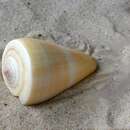fr
noms dans le fil d’Ariane


Der Eichenkegel oder die Eichen-Kegelschnecke (Conus quercinus) ist eine Schnecke aus der Familie der Kegelschnecken (Gattung Conus), die im Indopazifik lebt und Eichelwürmer und Vielborster frisst.
Der Körperumgang des Schneckenhauses von Conus quercinus ist breit kegelförmig und leicht konvex. Bei ausgewachsenen Schnecken erreicht das Haus eine Länge von 6 bis 14 cm. Die Grundfarbe des Gehäuses ist meist gelblich braun, in manchen Formen weiß. Die Oberfläche des Körperumganges ist in der Regel mehr oder weniger dicht mit feinen braunen, spiralig verlaufenden Linien überzogen. Das Gewinde ist konkav. Das Periostracum ist dunkelbraun oder grünlich braun, dick und undurchsichtig mit verwobenen Längsrippen.
Die Oberseite des Fußes ist vorn fast weiß und weiter hinten gelblich bis bräunlich, am Rand dunkelgrau begrenzt. Er ist vorn und in der Mitte mit Querreihen aus schwarzen Strichen, hinten mit vereinzelten schwarzen Strichen und weißen Punkten überzogen. Vor dem Operculum ist ein hellbrauner Fleck. Die gelblich graue Fußsohle ist braun gefleckt. Der Kopf und die Fühler sind kremfarben und haben schwarze Flecken. Der Sipho ist weiß bis bräunlich grau mit dunkelgrauen und schwarzen Flecken und Ringen.
Die Eichen-Kegelschnecke tritt im Roten Meer und in einem Großteil des Indischen und des Pazifischen Ozeans von der Küste Ostafrikas bis Hawaii und Französisch-Polynesien auf.
Eichen-Kegelschnecken leben unterhalb der Gezeitenzone auf Sand bis 70 Meter Tiefe.
Wie alle Kegelschnecken ist Conus quercinus getrenntgeschlechtlich, und das Männchen begattet das Weibchen mit seinem Penis. Aus den Eikapseln schlüpfen Veliger-Larven, die wiederum eine Metamorphose zur Schnecke durchmachen. Die Eikapseln sind 17–26 mm mal 17–22 mm groß. Eine Kapsel enthält etwa 10.000 Eier, die einen Durchmesser von 180 bis 200 µm haben. Hieraus wird zurückgeschlossen, dass die pelagische Periode der Veliger mindestens 25–30 Tage dauert. In Hawaii wurde bei einer Eigröße von 180 µm eine pelagische Periode von 30 Tagen beobachtet.
Eichen-Kegelschnecken fressen Eichelwürmer und Polychaeten, darunter Vertreter der Familie Terebellidae, die mittels einer Harpune mit einem giftigen Radulazahn getötet werden.
Conus quercinus ist auf Grund seiner gemusterten Gehäuse ein beliebtes Sammlerobjekt, so dass der Mensch als ein Hauptfeind gelten kann. Er wird allerdings nicht in der Roten Liste aufgeführt.[1]
Der Eichenkegel oder die Eichen-Kegelschnecke (Conus quercinus) ist eine Schnecke aus der Familie der Kegelschnecken (Gattung Conus), die im Indopazifik lebt und Eichelwürmer und Vielborster frisst.
Conus quercinus, common names the oak cone or the yellow cone, is a species of sea snail, a marine gastropod mollusk in the family Conidae, the cone snails and their allies.[1]
Like all species within the genus Conus, these snails are predatory and venomous. They are capable of "stinging" humans, therefore live ones should be handled carefully or not at all.
The size of the shell varies between 35 mm and 140 mm. The shell has a lemon-yellow color, with numerous fine, rather close, chestnut revolving lines. In old specimens the revolving lines become obsolete. The spire is rather elevated, with a concave outline. The shoulder of the body whorl is obtusely angulated.[2]
This species occurs throughout the Indo-Pacific including Hawaii, Republic of the Marshall Islands, French Polynesia, Fiji, New Caledonia, in the Red Sea, in the Indian Ocean off Aldabra, Chagos, the Mascarene Basin, Madagascar and Mauritius; off Eastern India, the tropical Indo-West Pacific and off Australia (Northern Territory, Queensland, Western Australia).
Conus quercinus, common names the oak cone or the yellow cone, is a species of sea snail, a marine gastropod mollusk in the family Conidae, the cone snails and their allies.
Like all species within the genus Conus, these snails are predatory and venomous. They are capable of "stinging" humans, therefore live ones should be handled carefully or not at all.
 Shell of Conus quercinus [Lightfoot], 1786, measuring 61.0 mm in height, collected in New Zealand.
Shell of Conus quercinus [Lightfoot], 1786, measuring 61.0 mm in height, collected in New Zealand.
Conus quercinus is een in zee levende slakkensoort uit het geslacht Conus. De slak behoort tot de familie Conidae. Conus quercinus werd in 1786 beschreven door Lightfoot.[1] Net zoals alle soorten binnen het geslacht Conus zijn deze slakken roofzuchtig en giftig. Ze zijn in staat om mensen te steken en moeten daarom zorgvuldig worden behandeld.[2]
Conus quercinus é uma espécie de gastrópode do gênero Conus, pertencente à família Conidae. [1]
Ốc cối vàng (Danh pháp khoa học: Conus quercinus) là một loài ốc biển trong họ Conidae. Chúng là loài ốc được ưa chuộng để lấy vỏ làm trang sức.
Ốc cối vàng có chiều dài trung bình 70mm với đường kính ngang tại chỗ rộng nhất khoảng 40mm và chiều dài tối đa 160mm với đường kính ngang 55mm. Kích cỡ chúng khoảng 30–140 mm. Vỏ của chúng có dạng trứng thuôn dài, kích cỡ trung bình. Vỏ dài, chắc và nặng. Chóp xoắn có dạng hình nón, vòng xoăn đều và láng. Khe hở của vỏ dài và rộng, có màu trắng; chỗ rộng nhất nằm ở chóp đầu. Màu sắc của vỏ thường là vàng nhạt.
Thức ăn của chúng là các loài động vật thân mềm khác Chúng được phân bố rất rộng, từ vùng dưới triều đến độ sâu khá lớn, nhưng thường sống chui trong các khe kẽ rạn san hô ở độ sâu từ 50 - 70m. Đôi khi thấy chúng vùi trong cát ở vùng rạn phẳng. Ốc cối vàng là loại ốc dùng để làm nút, trang trí. Chúng sống ở vùng xa bờ.
Loài ốc này xuất hiện ở Biển Đỏ, Ấn Độ Dương quanh Aldabra, Chagos, cao nguyên Mascarene; ngoài bờ biển Đông Ấn, vùng biển nhiệt đới Thái Bình Dương phía Tây Indonesia và ngoài khơi Australia (Lãnh thổ Bắc Úc, Queensland, Tây Úc).
Ốc cối vàng (Danh pháp khoa học: Conus quercinus) là một loài ốc biển trong họ Conidae. Chúng là loài ốc được ưa chuộng để lấy vỏ làm trang sức.
蜡黄芋螺(学名:Conus quercinus),是新腹足目芋螺科芋螺属的一种。主要分布于马来西亚、印度尼西亚、台湾,常栖息在沿岸。[1]